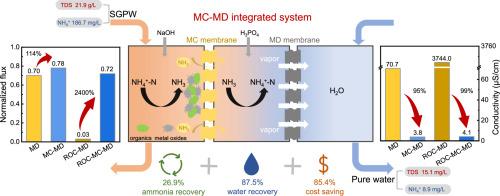膜接触器与膜蒸馏联用同时回收产水中的淡水和氨
IF 12.4
1区 环境科学与生态学
Q1 ENGINEERING, ENVIRONMENTAL
引用次数: 0
摘要
页岩气产出水(SGPW)的有效处理是一个巨大的挑战,而SGPW中的氨具有回收潜力。在本研究中,提出了膜接触器-膜蒸馏(MC-MD)一体化工艺,从SGPW原料和反渗透浓缩物(ROC)中回收不同进料pH条件下的淡水和氨。结果表明,MC预处理显著提高了MD性能,75%水采收率下的归一化通量提高了11.3% ~ 16.2%,渗透率稳定降至15 mg/L以下。氨通量和传质系数随着进料pH的增大而增大,在pH为10.5时达到最大氨通量2.47 g/(m2⸱h),在pH为11.5时达到最大传质系数60.5 m/h。然而,过高的pH值加速了饲料氨向空气中的扩散,从而增加了系统中氨的损失率。MC的加入减轻了MD膜的污染,使使用后膜的接触角增加到90.12 ~ 127.38°,比单一MD(60.67°)提高了48.5 ~ 110.0%。与传统方法相比,MC-MD系统降低了81.2-86.0%的成本,为高效处理SGPW提供了理论指导。本文章由计算机程序翻译,如有差异,请以英文原文为准。

Simultaneous recovery of fresh water and ammonia from produced water by membrane contactor coupled with membrane distillation
Efficient treatment of shale gas produced water (SGPW) is a great challenge, while ammonia in SGPW has potential for recovery. In this study, a membrane contactor-membrane distillation (MC-MD) integrated process was proposed to recover fresh water and ammonia under different feed pH conditions from raw and reverse osmosis concentrate (ROC) of SGPW. The results showed that MC as pretreatment significantly enhanced MD performance, improving the normalized flux at 75% water recovery by 11.3%-16.2% and steadily reducing permeate salinity to below 15 mg/L. The ammonia flux and mass transfer coefficient became larger as the feed pH increased, reaching maximum ammonia flux of 2.47 g/(m2⸱h) at pH of 10.5 and maximum mass transfer coefficient of 60.5 m/h at pH of 11.5. However, the excessively high pH accelerated the diffusion of feed ammonia into the air, which increased the percentage of ammonia loss from the system. The addition of MC mitigated MD membrane fouling, increasing the contact angle of the membranes after use to 90.12-127.38°, which was 48.5-110.0% improvement compared to single MD (60.67°). The MC-MD system reduced the 81.2-86.0% cost compared to traditional methods, providing theoretical guideline for efficient SGPW treatment.
求助全文
通过发布文献求助,成功后即可免费获取论文全文。
去求助
来源期刊

Water Research
环境科学-工程:环境
CiteScore
20.80
自引率
9.40%
发文量
1307
审稿时长
38 days
期刊介绍:
Water Research, along with its open access companion journal Water Research X, serves as a platform for publishing original research papers covering various aspects of the science and technology related to the anthropogenic water cycle, water quality, and its management worldwide. The audience targeted by the journal comprises biologists, chemical engineers, chemists, civil engineers, environmental engineers, limnologists, and microbiologists. The scope of the journal include:
•Treatment processes for water and wastewaters (municipal, agricultural, industrial, and on-site treatment), including resource recovery and residuals management;
•Urban hydrology including sewer systems, stormwater management, and green infrastructure;
•Drinking water treatment and distribution;
•Potable and non-potable water reuse;
•Sanitation, public health, and risk assessment;
•Anaerobic digestion, solid and hazardous waste management, including source characterization and the effects and control of leachates and gaseous emissions;
•Contaminants (chemical, microbial, anthropogenic particles such as nanoparticles or microplastics) and related water quality sensing, monitoring, fate, and assessment;
•Anthropogenic impacts on inland, tidal, coastal and urban waters, focusing on surface and ground waters, and point and non-point sources of pollution;
•Environmental restoration, linked to surface water, groundwater and groundwater remediation;
•Analysis of the interfaces between sediments and water, and between water and atmosphere, focusing specifically on anthropogenic impacts;
•Mathematical modelling, systems analysis, machine learning, and beneficial use of big data related to the anthropogenic water cycle;
•Socio-economic, policy, and regulations studies.
 求助内容:
求助内容: 应助结果提醒方式:
应助结果提醒方式:


